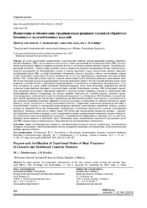| dc.contributor.author | Зеленковская, Ж. Л. | |
| dc.contributor.author | Ковшар, С. Н. | |
| dc.coverage.spatial | Минск | ru |
| dc.date.accessioned | 2023-04-19T10:49:53Z | |
| dc.date.available | 2023-04-19T10:49:53Z | |
| dc.date.issued | 2023 | |
| dc.identifier.citation | Зеленковская, Ж. Л. Назначение и обоснование традиционных режимов тепловой обработки бетонных и железобетонных изделий = Purpose and Justification of Traditional Modes of Heat Treatment of Concrete and Reinforced Concrete Products / Ж. Л. Зеленковская, С. Н. Ковшар // Наука и техника. – 2023. – № 2. – С. 150-157. | ru |
| dc.identifier.uri | https://rep.bntu.by/handle/data/127379 | |
| dc.description.abstract | В статье рассмотрены сравнительные характеристики наиболее распространенных режимов тепловлажностной обработки (ТВО), их достоинства и недостатки, а также предложения по оптимизации этапов ТВО для получения максимального эффекта ускорения твердения бетона за счет использования тепловой энергии. Тепловлажностная обработка бетона – один из самых сложных этапов в технологии сборного и монолитного бетона. Основой долговечности конструкций, их бесперебойной службы в течение проектного срока эксплуатации является правильно подобранный режим ТВО, который обеспечивает повышение качества изделий и снижает материальные затраты в виде сокращения энергозатрат. Поэтому неприемлемы до сих пор практикуемые упрощенные методики подбора режима ТВО. Только при условии строгого и научно обоснованного учета комплекса факторов, оказывающих влияние на протекающие процессы формирования структуры цементного камня и бетона и взаимодействия между ними, возможно получение бетона с требуемыми характеристиками. В зависимости от требований, предъявляемых к готовому материалу на основе знания механизма тепломассопереноса, могут быть рассчитаны рациональные методы и режимы термообработки бетонных и железобетонных изделий. Разнообразие режимов ТВО обусловлено стремлением уменьшить возможность образования дефектов в структуре бетона (например, режимы со ступенчатым либо криволинейным набором температуры, что снижает градиент температур по сечению изделия), сократить энергозатраты (режимы с исключением стадии изотермической выдержки) и др. В процессе ТВО бетонных и железобетонных изделий происходит ряд химических и физических преобразований бетонной смеси (бетона), в результате которых возможно появление различных дефектов в структуре материала, ухудшающих его свойства (прочность, проницаемость, усадку, ползучесть и в целом долговечность бетона). Современная технология производства бетонных и железобетонных изделий и конструкций предусматривает введение разнообразных химических добавок, влияние которых на твердение бетона при повышенных температурах, к сожалению, недостаточно отражено в специальной литературе. Например, длительность общего цикла ТВО бетона при использовании химических добавок – ускорителей твердения может быть сокращена за счет уменьшения периодов предварительной выдержки, подъема температуры и продолжительности изотермической выдержки; а применение пластификаторов в зависимости от их вида и содержания может привести к удлинению цикла. Необходимо иметь аналитические зависимости для расчетов режимов ТВО и компьютерную модель процесса твердения бетона при повышенных температурах. | ru |
| dc.language.iso | ru | ru |
| dc.publisher | БНТУ | ru |
| dc.title | Назначение и обоснование традиционных режимов тепловой обработки бетонных и железобетонных изделий | ru |
| dc.title.alternative | Purpose and Justification of Traditional Modes of Heat Treatment of Concrete and Reinforced Concrete Products | ru |
| dc.type | Article | ru |
| dc.identifier.doi | 10.21122/2227-1031-2023-22-2-150-157 | |
| local.description.annotation | The paper presents the comparative characteristics of the most common modes of heat and moisture treatment (HMT), their advantages and disadvantages, as well as proposals for optimizing the HMT stages to obtain the maximum effect of accelerating concrete hardening through the use of thermal energy. Heat and moisture treatment of concrete is one of the most difficult stages in the technology of prefabricated and monolithic concrete. The basis for the durability of structures, their uninterrupted service during the design period of operation is a properly selected HMT mode, which improves the quality of products and reduces material costs in the form of a reduction in energy costs. Therefore, the still practiced simplified methods for selecting the HMT mode are unacceptable. Only under the condition of strict and scientifically substantiated consideration of a complex of factors influencing the ongoing processes of formation of the structure of cement stone and concrete, and the interaction between them, it is possible to obtain concrete with the required characteristics. Depending on the requirements for the finished material, based on knowledge of the mechanism of heat and mass transfer, rational methods and modes of heat treatment of concrete and reinforced concrete products can be calculated. A variety of HMT modes is due to the desire to reduce the possibility of defects in the concrete structure (for example, modes with a stepped or curvilinear temperature increase, which reduces the temperature gradient across the product section), to reduce energy costs (modes with the exclusion of the isothermal holding stage), etc. In the process of HMT of concrete and reinforced concrete products, a number of chemical and physical transformations of the concrete mixture (concrete) occur, as a result of which various defects in the structure of the material may appear, which worsen its properties (strength, permeability, shrinkage, creep and, in general, durability of concrete). Modern technology for the production of concrete and reinforced concrete products and structures provides for the introduction of various chemical additives, their effect on the hardening of concrete at elevated temperatures, unfortunately, is not sufficiently reflected in the specialized literature. For example, the duration of the total cycle of concrete HMT when using chemical additives – hardening accelerators can be reduced by reducing the periods of preliminary exposure, temperature rise and the duration of isothermal exposure; and the use of plasticizers, depending on their type and content, can lead to a lengthening of the cycle. It is necessary to have analytical dependencies for calculating HMT modes and a computer model of the concrete hardening process at elevated temperatures. | ru |

